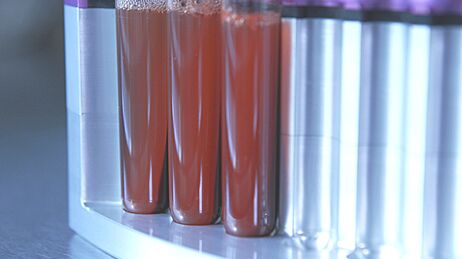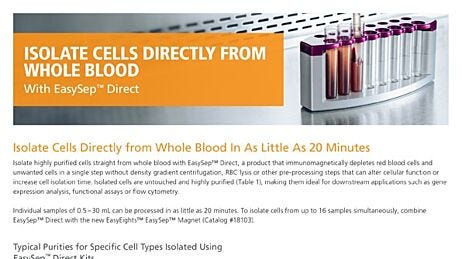EasySep™ Direct
Isolate Cells Directly from Whole Blood in As Little As 20 Minutes
Isolate highly purified cells straight from whole blood with EasySep™ Direct, a new product that immunomagnetically depletes red blood cells and unwanted cells in a single step without density gradient centrifugation, sedimentation, RBC lysis or other pre-processing steps that can alter cellular function or increase cell isolation time. Isolated cells are untouched and highly purified, making them ideal for downstream applications such as gene expression analysis, functional assays or flow cytometry.
Individual samples of 0.5 – 30 mL can be processed in as little as 20 minutes. To isolate cells from up to 16 samples simultaneously, combine EasySep™ Direct with the new EasyEights™ EasySep™ Magnet.
Why Use EasySep™ Direct?
- Deplete up to 99.9% of RBCs without the need for lysis or centrifugation.
- With no columns or washes, the cell isolation is fast and simple.
- Target cells are highly purified and immediately available for downstream applications.
How Does EasySep™ Direct Work?
EasySep™ Direct immunomagnetically depletes red blood cells and unwanted cells in a single step without density gradient centrifugation, RBC lysis or other pre-processing steps that can alter cellular function or increase cell isolation time. This video provides a brief introduction to this new immunomagnetic platform for fast and easy cell isolation from up to 16 samples at once.
Typical EasySep™ Direct Protocol

Typical Profile

Figure 1. Typical EasySep™ Direct CD4+ T Cell Isolation Profile
Starting with human whole blood from normal healthy donors, the typical CD4+ T cell (CD3+CD4+) content of the isolated fraction is 93.6 ± 2.5% (gated on CD45) or 93.1 ± 2.5% (not gated on CD45). In the above example, the CD4+ T cell (CD3+CD4+) content of the lysed whole blood start sample and non-lysed final isolated fraction is 16.5% and 95.8% (gated on CD45), respectively, or 16.3% and 95.1% (not gated on CD45), respectively. The starting frequency of CD4+ T cells in the non-lysed whole blood start sample is 0.016% (data not shown).
Table 1. Typical purities for specific cell types isolated using EasySep™ Direct
| Cell Type | Typical Purity |
|---|---|
| Total Lymphocytes | 96.7 ± 1.5% |
| T Cells | 95.3 ± 1.4% |
| CD4+ T Cells | 93.6 ± 2.5% |
| CD8+ T Cells | 82.4 ± 4.9% |
| B Cells | 95.3 ± 2.7% |
| B Cells from B-CLL Samples | 87.0 ± 7.6%* |
| Naive B Cells | 91.8 ± 3.6% |
| NK Cells | 76.8 ± 12.2% |
| Neutrophils | 97.3 ± 1.4% |
| Granulocytes | 98.4 ± 1.5% |
| Monocytes | 82.2 ± 8.4% |
| Mononuclear Cells | 98.3 ± 2.8% |
| Circulating Tumor Cells (CTC's) | 2.9 - 3.2 Log Depletion |
| Basophils | 97.3 ± 1.1% |
| Eosinophils | 95.8 ± 2.7% |
| Peripheral Blood Mononuclear Cells (PBMCs) | 98.3 ± 2.8% |
Video Protocol Using EasySep™ Purple and Silver Magnets
This video demonstrates how to isolate highly purified immune cells directly from whole blood with EasySep™ Direct on the EasySep™ (Purple/Silver) Magnet platform. The protocol takes as little as 20 minutes from start to finish.
Video Protocol Using Easy 50 EasySep™ Magnet
This video demonstrates how to isolate highly purified immune cells directly from whole blood samples up to 30 mL with EasySep™ Direct on the Easy 50 EasySep™ Magnet. The protocol takes as little as 30 minutes from start to finish.
Isolate Cells from Blood
Learn about various methods to isolate different cell populations from blood samples.
On-Demand Course on Human Immune Cell Isolation
Learn how to effectively process human samples and isolate highly pure target cells with EasySep™ in this free self-paced course.
Cell Separation Guide E-Book
Download a practical guide, complete with step-by-step protocols, to learn everything you need to know about common cell isolation techniques.









